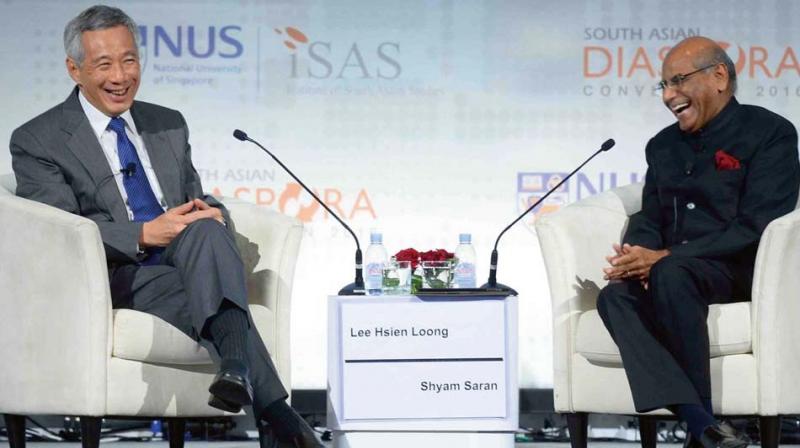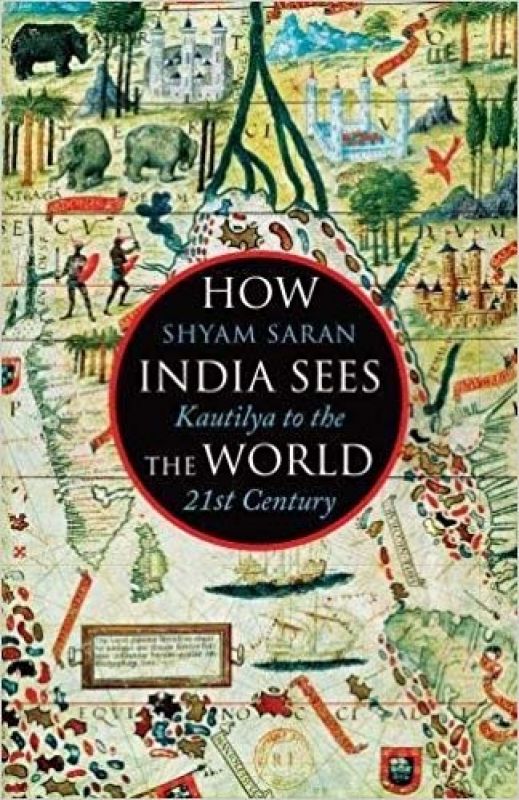Book review 'How India Sees the World': Insights on stagecraft from a wise diplomat
The former diplomat's insight couldn't come at a better time as India shifts inexorably into the US ambit.

Former US envoy to India Robert Blackwill says of Shyam Saran’s book, How India Sees the World, ‘If you can only read one book on how India should conduct itself as world order fractures, read this one’. As PM Narendra Modi puts in place a far more muscular foreign policy, Mr Saran’s insight into the three countries that present India with its biggest foreign policy challenges, ‘unpredictable’ America as much as China and its South Asia proxy, Pakistan, is instructive on how India’s past triumphs and failures continually intrude into its present...
The singular flaw in former ambassador Shyam Saran’s book How India Sees the World, that has otherwise received high praise from the political and diplomatic class and academia as an “indispensable frame of reference for the country’s current external challenges,” is the unfortunate media hype that has unnecessarily picked out one aspect — blaming then Prime Minister Manmohan Singh for India’s handling of Siachen — while ignoring the book’s singularly well-crafted posits on the far bigger challenge of checkmating China.
As the acknowledged China hand states, in a near perfect de-construct of the Chinese mindset: “There is a certain subtlety to the Chinese use of deception, which escapes most Indians.”
Saran could have been talking about Pakistan, where civilian Islamabad continually uses our Achilles heel of shared language and culture to throw dust in India’s eyes. Saran writes about how times had changed when he took over as foreign secretary and how that remained so, under his successor, Shiv Shankar Menon.
“The prevailing sentiment that Pakistan had to be isolated and that there should be no engagement unless and until Pakistan abandoned its use of cross-border terrorism as an instrument of state policy,” had been watered down by the Manmohan Singh government, despite the Lahore, Kargil and Agra fiascos under the preceding Atal Behari Vajpayee’s government.
Indeed, lost in the din of the ill-informed blame-game on Siachen that has erupted today, over keeping the Indian Army out of the loop on Siachen, is that the Indian Army was, in fact, fully on board, both during the drafting of the agreement and when it came to finally nixing the proposal on withdrawing from the commanding heights, that it had occupied in the pre-emptive strike, Operation Meghdoot in 1984.
In recalling the run up to the aborted Siachen deal that he had worked on, Mr Saran writes how Pakistan, “in the early 1980s, had begun to issue permits for international mountaineering expeditions to the Siachen Glacier area, thereby asserting its jurisdiction over it” even as “the entire glaciated area comprising the Siachen Glacier and the Saltoro Ridge, covering an area of over 2300 square kilometres, came to be shown as under Pakistani control,” under most international maps. The Indian army changed the status quo with Operation Meghdoot.
 How India Sees The World: Kautilya to the 21st Century; by Shyam Saran; Juggernaut, Rs 599.
How India Sees The World: Kautilya to the 21st Century; by Shyam Saran; Juggernaut, Rs 599.
Saran had crafted the draft agreement on Siachen in 2006 on Prime Minister Manmohan Singhs instructions that he “obtain a consensus on it from all the key stakeholders in our own system”.
“Many rounds of consultations, both at the senior bureaucratic and ministerial levels in the ministries of defence, home and finance. The army chief J.J. Singh and the intelligence chiefs were also brought on board.
“The technical details of the agreement, including the points and timing of redeployment, the phases in which it would be implemented and the structure of the monitoring mechanism, were actually worked out at the army headquarters by the director-general of military operations...
When the CCS meeting was held on the eve of the defence secretary–level talks, the then national security advisor (NSA) M.K. Narayanan launched into a bitter offensive against the proposal, saying that Pakistan could not be trusted, that there would be political and public opposition to any such initiative and that India’s military position in the northern sector visà- vis both Pakistan and China would be compromised.
That the diplomat in Saran saw this as a window of opportunity to make history was clear. But a strategic and military imperative took precedence over the diplomatic hand-holding of untrustworthy Pakistan that had been embarked on by the preceding Atal Behari Vajpayee’s BJP government and was sustained by Manmohan Singh without factoring in the unchanging hold of the military-jihadists who run Pakistan.
PM Vajpayee’s Pakistan outreach was made under the mistaken belief that under civilian PM Nawaz Sharif, the military would not play dirty, post-Lahore. And second, when they did play dirty with the Kargil infraction, and army chief Gen. Pervez Musharraf who was behind Kargil, subsequently took over as “Chief Executive”, India still embarked on the Agra summit, believing that they were finally dealing with the real power centre, failing to factor in, that President Musharraf’s Mohajir antecedents would always be held against him unless he toed the deep state’s line.
The former diplomat’s insight couldn’t come at a better time as India shifts inexorably into the US ambit.
As India’s foreign secretary and later, the prime minister’s special envoy, he worked closely with the US, which was clearly unused to dealing with a country that was neither an ally nor an adversary but aspired to equality. Saran spent three years, networking with “multiple centres of power and influence in Washington” to forge the Indo-US civil nuclear agreement that once signed, marked as he writes, a dramatic end to several decades of estrangement.
As this new India under Prime Minister Narendra Modi adopts a singularly muscular and assertive foreign policy and moves inexorably into the US ambit and stares at the far greater challenge of checkmating the much bigger power of China and its South Asian proxy, Pakistan, the candid insights and penetrating analyses that the former foreign secretary has brought to bear in his debut treatise couldn’t have been timed more perfectly.
Saran’s telling of the Siachen fiasco must be seen in that context, and perhaps what he has left unsaid — the unspoken rivalry that divides Indian officialdom, the faultlines that run through that puts diplomats like Saran on one side and officials like the former national security adviser, M.K. Narayanan on the other, while elected politicians play referee.
Given his inside knowledge of the policy deliberations that went on behind closed doors — and which he has freely shared — Saran’s rendering of events when he was chief negotiator on the Indo-US civil nuclear agreement with an “unpredictable America,” his handling of “adversarial” Pakistan and the fascinating critique on the rise of Chinese power are as insightful as they are thought-provoking.
On Narasimha Rao
“In my view, Narasimha Rao represented the Kautilyan mind more than any other Indian leader in recent times. He could be cold and calculating in handling the many challenges he had to confront but had an occasional streak of humour that took one by surprise. In one of his reflective moods, he turned to me and asked, ‘Do you know the attributes of a successful leader in India?’ Before I could respond to this unexpected query, he answered it himself: ‘To be a successful leader in India you must be ruthless but also ascetic’.”
Excerpt
When Nawaz backed down
It was during my time as joint secretary at the PMO from 1991 to 1992 that I became more closely involved with our Pakistan policy. I had succeeded Ronen Sen at the PMO when Chandra Shekhar was the prime minister. Th e former prime minister, Rajiv Gandhi, had been killed in a terrorist attack on May 21, 1991, and his funeral in Delhi was a few days later. Several heads of state and government leaders came to pay their respects, among them the Pakistani prime minister, then a much younger Nawaz Sharif. Chandra Shekhar hosted a private lunch for him at 7 Race Course Road, which was followed by a one-to-one meeting, which I covered as a notetaker. A crisis had been building up on the LoC in Jammu and Kashmir, where a large number of Pakistanis were gathering, threatening to cross over to the Indian side to “unite divided Kashmir” through “people power”.
Nawaz Sharif tried to argue that the Pakistani government, despite its best eff orts, may not be able to stop the groups from crossing the LoC. He said he expected restraint on the Indian side. Chandra Shekhar said it was the responsibility of Pakistan to prevent any crossing of the LoC from its side. As prime minister of India, he would have no option but to order his security forces to shoot anyone trespassing on Indian soil.
This would be a violent act against unarmed people and would be condemned across the world, warned Nawaz. Chandra Shekhar said it was his responsibility to handle the fallout, but he wanted the Pakistani prime minister to be under no doubt that if one person crossed, one would be killed, and if a hundred crossed, a hundred would be killed. Nawaz hastily dropped the subject and moved on to less contentious issues. Over the next few days, Pakistani security forces moved decisively to prevent the gathering groups from crossing the LoC and soon they melted away.
China obfuscation in maps
Two instances illustrate how India’s lack of familiarity with Chinese strategic culture created a misplaced sense of assurance. During the early 1950s, Nehru took up with Zhou Enlai the matter of Chinese maps showing large parts of Indian territory as part of China. Zhou Enlai explained that they were old Kuomintang maps which had not been reviewed and revised. He did not acknowledge that they were wrong. Yet the impression created was that China accepted the boundary as drawn on Indian maps.
The other misunderstanding was about the Chinese position on Kashmir. Some months before the 1962 border war, secretary general in the MEA, R.K. Nehru, met Zhou in Beijing. Nehru drew Zhou’s attention to reports that China was leaning towards the Pakistani position that Jammu and Kashmir was disputed territory. He reminded the Chinese premier that on an earlier occasion, when asked if China recognized Indian sovereignty over Jammu and Kashmir, he had replied, rhetorically, “Has China ever said that it did not?” Now Zhou turned this same formulation on its head and asked Nehru, “Has China ever said that it did recognise Indian sovereignty over Jammu and Kashmir?”
In both instances, the Indian side did not press the Chinese to convey categorical and unambiguous assurances. If the Chinese had demurred, as they might have, we would have at least been better prepared to handle the subsequent problems we had with them.

